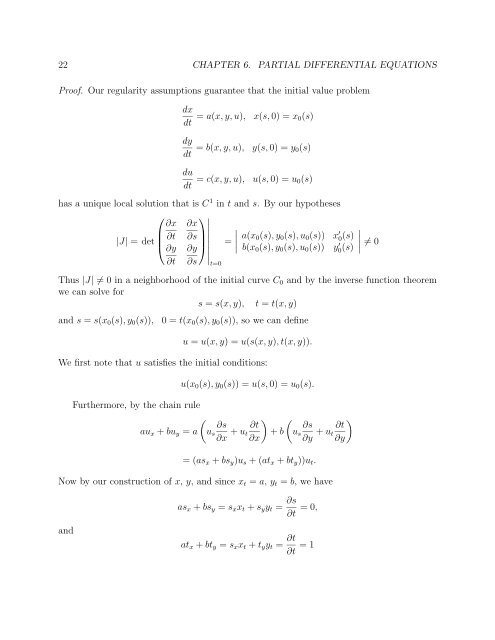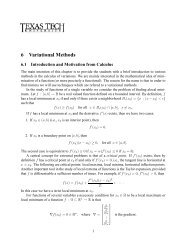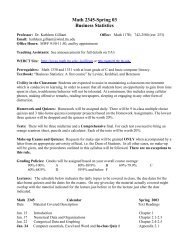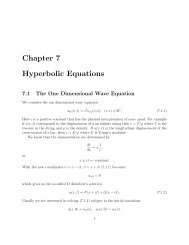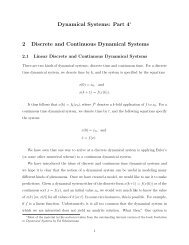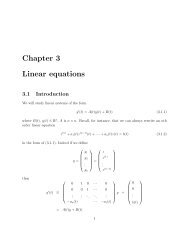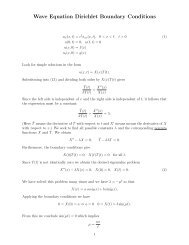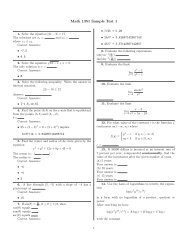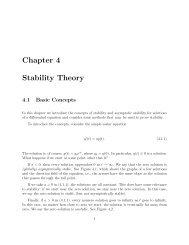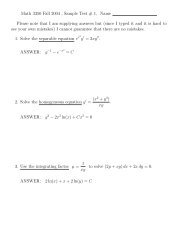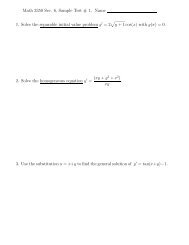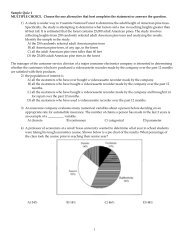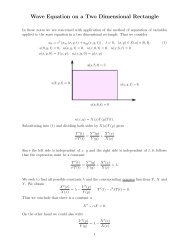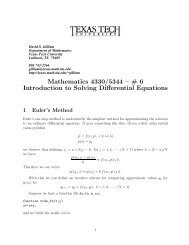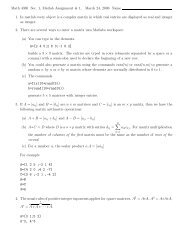Chapter 6 Partial Differential Equations
Chapter 6 Partial Differential Equations
Chapter 6 Partial Differential Equations
You also want an ePaper? Increase the reach of your titles
YUMPU automatically turns print PDFs into web optimized ePapers that Google loves.
22 CHAPTER 6. PARTIAL DIFFERENTIAL EQUATIONS<br />
Proof. Our regularity assumptions guarantee that the initial value problem<br />
dx<br />
dt<br />
dy<br />
dt<br />
du<br />
dt<br />
= a(x, y, u), x(s,<br />
= b(x, y, u), y(s,<br />
= c(x, y, u), u(s,<br />
0) = x 0(s)<br />
0) = y 0(s)<br />
0) = u 0(s)<br />
has a unique local solution that is C 1 in t and s. By our hypotheses<br />
⎛ ⎞<br />
∂x ∂x<br />
|J| = det ⎜ ∂t ∂s<br />
⎟<br />
⎝∂y<br />
∂y⎠<br />
=<br />
∣ a(x 0(s),y 0 (s),u 0 (s)) x ′ 0(s)<br />
b(x 0 (s),y 0 (s),u 0 (s)) y 0(s)<br />
′<br />
∣<br />
∂t ∂s t=0<br />
∣ ≠0<br />
Thus |J| ≠ 0 in a neighborhood of the initial curve C 0 and by the inverse function theorem<br />
we can solve for<br />
s = s(x, y), t = t(x, y)<br />
and s = s(x 0 (s),y 0 (s)),<br />
0=t(x 0 (s),y 0 (s)), so we can define<br />
u = u(x, y) =u(s(x, y),t(x, y)).<br />
We first note that u satisfies the initial conditions:<br />
u(x 0 (s),y 0 (s)) = u(s, 0) = u 0 (s).<br />
Furthermore, by the chain rule<br />
(<br />
)<br />
∂s<br />
au x + bu y = a u s<br />
∂x + u ∂t<br />
t<br />
∂x<br />
(<br />
∂s<br />
+ b u s<br />
=(as x + bs y )u s +(at x + bt y ))u t .<br />
)<br />
∂y + u ∂t<br />
t<br />
∂y<br />
Now by our construction of x, y, and since x t = a, y t = b, wehave<br />
and<br />
as x + bs y = s x x t + s y y t = ∂s<br />
∂t =0,<br />
at x + bt y = s x x t + t y y t = ∂t<br />
∂t =1


